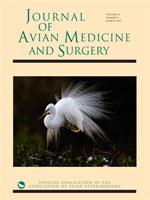Manual restraint is commonly necessary when working with avian species in medical, laboratory, and field settings. Despite their prevalence, little is known about the stress response in raptorial bird species. To further understand the effect of restraint on the stress response in birds of prey, 12 barred owls (Strix varia) were manually restrained for 15 minutes. Physiological parameters (cloacal temperature, respiratory rate, heart rate) were followed over time and recorded at defined points during the restraint period. Heart rate decreased significantly over the restraint period by a mean ± SD of −73 ± 46 beats/min. Respiratory rate also decreased significantly (median: −11 breaths/min, interquartile range: −8 to −18). Cloacal temperature increased significantly over time in manually restrained owls (median: 1.5°C [ 2.7°F], interquartile range: 1.3°C–2.1°C [2.3°F–3.8°F]). This study is the first to document stress hyperthermia in an owl species. Similar to another raptorial bird, the red-tailed hawk (Buteo jamaicensis), both heart rate and respiratory rate decreased and cloacal temperature increased over time in restrained barred owls. Barred owls appear to cope differently to restraint stress when compared to psittacine species.
How to translate text using browser tools
1 March 2016
The Effect of Manual Restraint on Physiological Parameters in Barred Owls ( Strix varia)
Grayson A. Doss,
Christoph Mans
ACCESS THE FULL ARTICLE
Avian
Barred Owl
bird of prey
handling
raptor
stress-induced hyperthermia
Strix varia





